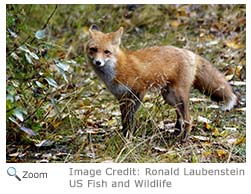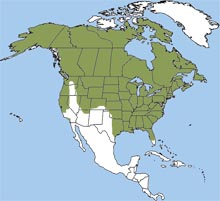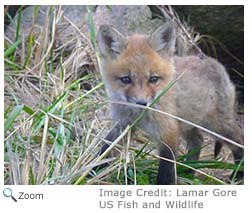Red Fox - Vulpes vulpes |
|||||||
Description Range HabitatThe red fox makes its home in wooded areas, prairies and farmland. DietThe red fox eats a wide variety of foods. It is an omnivore and its diet includes fruits, berries and grasses. It also eats birds and small mammals like squirrels, rabbits and mice. A large part of the red fox's diet is made up invertebrates like crickets, caterpillars, grasshoppers, beetles and crayfish. The red fox will continue to hunt even when it is full. It stores extra food under leaves, snow or dirt. | Life Cycle BehaviorThe red fox is mostly nocturnal, although it will sometimes venture out in the day. The red fox, unlike other mammals, hears low-frequency sounds very well. It can hear small animals digging underground and will frequently dig in the dirt or snow to catch prey. The red fox stalks its prey much like a cat. It gets as close as it can and then pounces and chases its prey. Except for breeding females, the fox doesn't usually use a den. Sometimes it will sleep in the open, wrapping its bushy tail around its nose to stay warm. When it does use a den, it will usually find an abandoned rabbit or marmot den instead of making its own den.
|
||||||


 The red fox can be found in most of the United States and Canada, except for the far north in Canada and Alaska and much of the western U.S. and Hawaii. The red fox is found throughout New Hampshire. The red fox is also found in Europe and Asia and it has been introduced to Australia.
The red fox can be found in most of the United States and Canada, except for the far north in Canada and Alaska and much of the western U.S. and Hawaii. The red fox is found throughout New Hampshire. The red fox is also found in Europe and Asia and it has been introduced to Australia.

